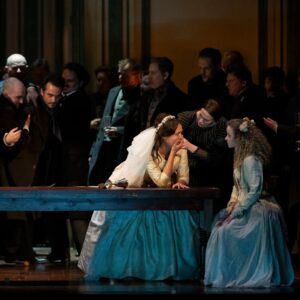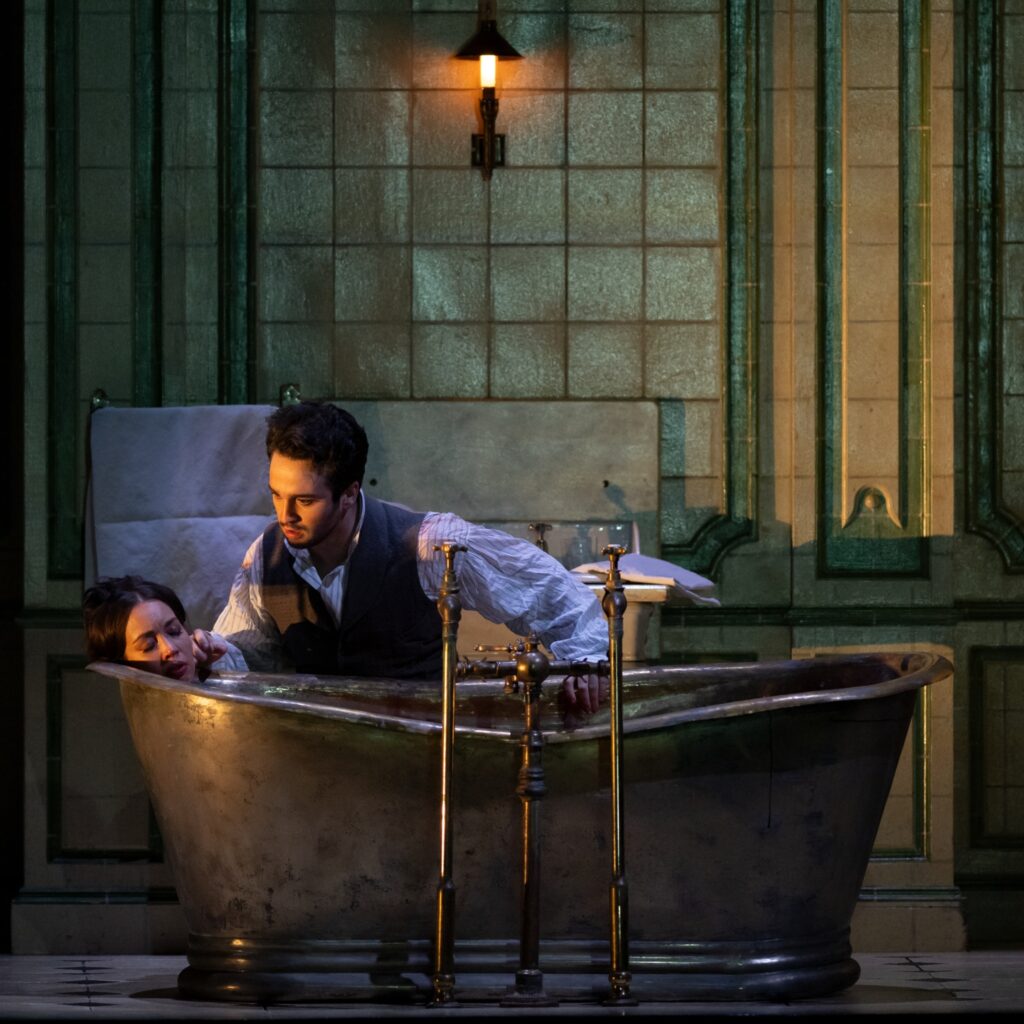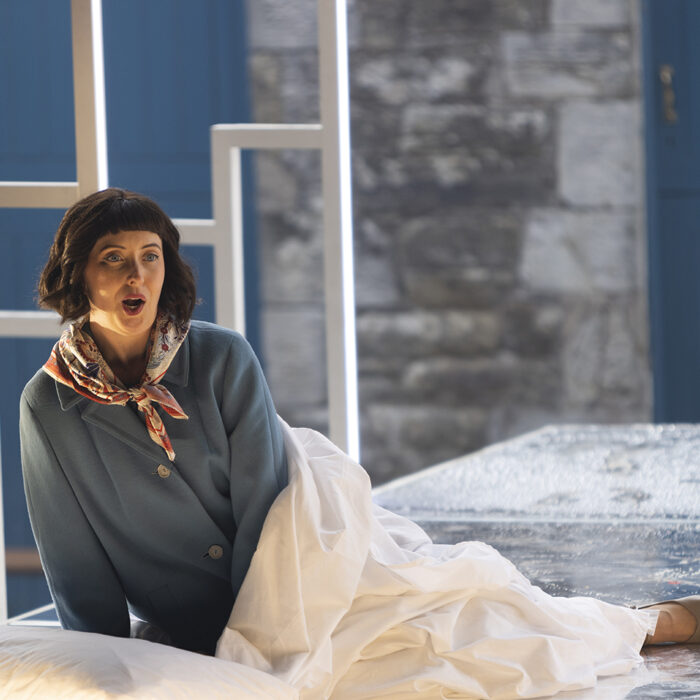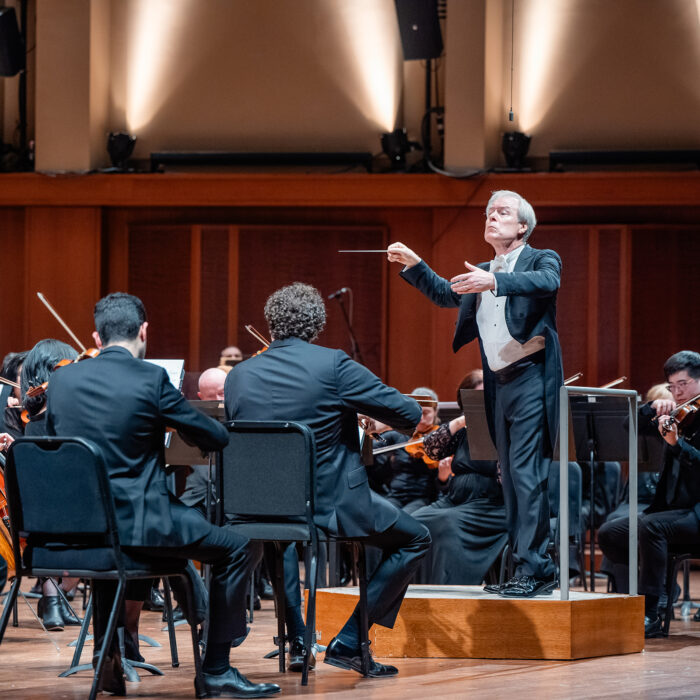
Royal Opera House 2023-24 Review: Lucia di Lammermoor
A Strong Cast Makes Up for Katie Mitchell’s Brutal Production
By Mike HardyI have more than once commented that OPERA, no matter the tale, should always be about the music; specifically, the singing, above and beyond anything else. It is, after all, what truly defines the art.
And in Katie Mitchell’s and Robin Tebbutt’s revival production of Donizetti’s tragic opera, the singing is inarguably superlative.
Alas, this is a truly grim tale. REALLY grim. Many operas, almost quintessentially, have unhappy endings but in this case, it has unhappy beginnings, middle, and an end. It reeks with an austere miserableness from the outset that goes downhill from then on in. Suffice to say that where English playwright Frederick Knott elected to call his famous tale, (a subsequent famous Hitchcock film), ‘Dial ‘M’ for Murder’, Donizetti could have called this ‘Dial ‘M’ for Murder, Mayhem, Malevolence, Moroseness, Morbidity, and (ultimately), MADNESS.
I’m not one for contextualizing or elaborating on plots, suffice to say that this tale of woe, based on Sir Walter Scott’s 1819 historical novel ‘The Bride of Lammermoor’, is an unpliant confection of thwarted love, jealous rivals, feuding families, deception, and obsession. Ostensibly, just your average potpourri for dramma tragico, then, but this has something else. The genuinely creepy phantasms, ghosts of a murdered Lammermoor girl and of Lucia’s Mother that wander in and out of many of the scenes, serve to illustrate and accentuate the foreboding of the misery about to unfold.
Mixed Bag
The production here, by Katie Mitchell and Vicki Mortimer, splits the stage into two; providing a living split-screen presentation; the main story unfolding in one half whilst the other provides some context or ancillary backdrop. This serves as a major distraction at times, a fruitful embellishment at others. For example, it proves impossible, I would respectfully suggest, to concentrate on the banquet room half of the stage where Edgardo the dejected, (and now REJECTED), tenor is being taunted by his enemy, Enrico; whilst in the other half of the stage, his true love, Lucia, is engaging in some rather alluring behavior with her newlywed husband whom she is about to murder.
Conversely, in Act two, it works rather well as the stage is split into Lucia’s bedroom and bathroom, which in addition to being a visually natural division, the latter serves well in providing both a place of refuge for Lucia from her brother’s cruel and insistent manipulations as well as the toilet itself used to announce her obvious early stage pregnancy, courtesy of her morning sickness.
Lighting designer Jon Clark couldn’t have done a better job, creating the right amount of oppressive illumination in these scenes, although it could be argued that NO amount of light could have banished the ever-present sense of gloom and doom. There was even an almost parodical display of sheet lightning at the window of Lucia’s bedroom as she anticipated her wedding night, somewhat reminiscent of a scene from one of the kitsch ‘Hammer House of Horror’ movies.
The set designs themselves were effective and visually realistic, although the split staging meant that the cramming of an ensemble of performers and chorus into such a restricted space often looked unnatural, especially given that the other half of the stage was frequently either empty or inhabited only by one or two people.
Great Voices
As stated earlier, it is my contention that opera should be first, and foremost about the singing, and this performance was resplendent with great voices.
Polish baritone Artur Ruciński took the role of Enrico Ashton, the Master of Lammermoor and cruel, domineering brother to Lucia. Acting the role with just the right amount of menace, his voice appeared tentative in the opening scene before quickly gathering momentum. A rich, mellow baritone, he produced an astonishing display of breath control at the cessation of the opening act on the final phrase, ‘spegnerò’, albeit for way longer than Donizetti ever intended it to be sung.
I have opined previously on the merits of young Scottish tenor and Jette Parker Artist member Michael Gibson, and he appears here again displaying great vocal talents and acting ability as Normanno, a somewhat consigliere to the villainous Enrico. He has a fine, lyric tenor voice and it is surely a question of time before he is engaged on the stage in more demanding roles.
A tenor whose star has been ascending for a while now is that of Spanish-born Xabier Anduaga, here as Edgardo, Lucia’s true love. Making his house debut here in this role, his early interactions were, seemingly, cautious, but his duet with Lucia, ‘Verranno a te sull’aure’, was suitably emotive and his clean, bright tenor palette began to shine. By the time we reached the final act at the crypt, he produced a most excellent ‘Tombe degli avi miei / fra poco a me ricovero’ with beautifully nuanced phrasing, and his final scenes with the departed Lucia where he elects to join her, are genuinely heart-rending, especially where he peppers his phrases with divine sotto voci. He even infused his laments with what I interpreted as being a high ‘D’, albeit it falsetto. This was the first time I experienced this tenor live and I look forward to hearing him more. I have no doubt that the Royal Opera House, along with other houses, will be eager to engage him further.
Korean bass Insung Sim, as Raimondo Bidebent cuts an imposing figure as the very formal Chaplin. He possesses a rich, warm, round voice and propounds a perfect stage presence here as a suitably stern authoritarian.
Former Jette Parker member, Uruguayan tenor Andres Presno, is cast as the luckless Arturo Bucklaw whose competent tenor voice is evident in an all too brief appearance, his singing role rather eclipsed by the salacious shenanigans that precedes his demise.
British Mezzo Rachael Lloyd delivers a touching, compassionate performance as Lucia’s Maid and companion, another voice I would have liked to have heard more of.
In the past, many performances of “Lucia di Lammermoor” were staged purely to illustrate the vocal prodigiousness of the soprano in what is, unequivocally, one of opera’s most challenging roles. Whenever the role is mentioned, the cognoscenti will undoubtedly hark back to those efforts of the late great, Dame Joan Sutherland. Even contemporary reviews of the opera will recall and, sometimes, even compare the Lucia of the day with that of the Dame. If any of that prayed on the mind of THIS performance of Lucia, Nadine Sierra, then not only did it not show, but she was, seemingly, intent on setting a few benchmarks of her own. Perhaps ALL the artists here mutually agreed to start proceedings gently as she, too, announced her entry with a touch of diffidence. However, she quickly proceeded to deliver a mesmerizing rendition of “Regnava nel silenzio” that elicited a, virtually, raucous audience response, before delivering a beautiful and convincing duet with lover Edgardo to close the act.
In the infamous ‘Mad’ scene, she displayed an astonishing array of the coloratura’s armory; trills, stacatti, ornate, and most agile arpeggios, and runs, yet infused with frequent and stirring pianissimos. Her top was secure, (E flat, at that), and she possesses amazing breath control. MORE than that, she has utterly convincing dramatical skills and acting prowess. Her inner turmoil and pain were frequently almost tangible, and her descent into absolute madness was accentuated by two collapses on stage where she effected an astonishing replication of a marionette whose strings had been rapidly severed, apparently striking her head against the leg of the billiard table in the process. A true tour de force, this was one of the most exciting, palpable, and powerful soprano performances I have witnessed.

Excellent Support
The Royal Opera House orchestra rarely fails to impress, and on this occasion, they replicated a beautiful Donizetti score under the skillful baton of Giacomo Sagripanti. Extra kudos must go to the chorus members, whose labors must surely have been intensified due to the constricted spaces, and a note of excellence must also be afforded to the remarkably skilled harpist who performed the harp solo.
In 2016, Katie Mitchell spoke about the “strong feminist agenda” she had for her new staging of Donizetti’s “Lucia,” which I’m sure pleased those who occupy the board rooms and ‘creative corners’ of those opera houses who are hell-bent on producing contentious, outrageous or provocative material for the sake of sensationalist headlines, no matter how far removed from the composers intentions their visions may be.
True, this telling isn’t hugely removed from the original in general, but it far too frequently resorted to barbarism to somehow accentuate the malevolence of its inherent patriarchy; something which I considered as both unnecessary and gimmicky. The tale, even in its most simplistic form, is testament enough to the gross inequalities and inequities of the time and the fact that Lucia’s brother, Enrico, deliberately plotted, lied, and fabricated to coerce his sister into marrying for his own gain is an act that would warrant unanimous audience repulsion from all quarters. Men included. I found certain aspects of the production and direction to be superfluously brutal and bordering on being misandristic. Enrico was a sufficiently unpleasant individual without having him explode with threatening, violent menace when insisting that Lucia marries Arturo. Lucia’s miscarriage is garish, the entire lower half of her body drenched with the blood of her loss, a symbol of the perceived crimes inflicted upon her by men, yet the crime she herself commits, a murder via multiple, stabbing creates no visible blood at all. Poor Arturo never even got to bleed! Even the hero, Edgardo, her lover, is seen to strike her to the ground when he confronts her upon realizing she has married another.
In conclusion, as I commenced, this is a most commendable and beautifully sung opera, but its staging and direction are frequently and gratuitously barbarous and brutish. The tale, its characters, and its plot can elicit suitable empathy, repulsion, and consternation in us all.



